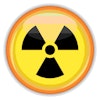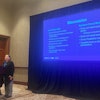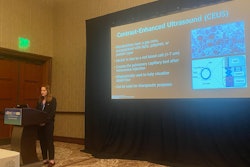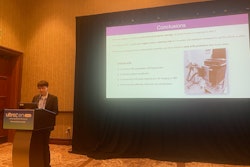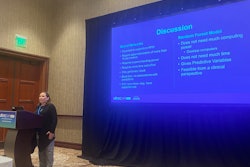Work-related musculoskeletal (MSK) disorders are tied to work-related burnout among sonographers, according to research highlighted April 10 at UltraCon.
In her presentation, Jennifer Bagley from the University of Oklahoma Health Sciences Center discussed her team’s results showing that many sonographers who score high on the Oldenburg Burnout Inventory also reported having a work-related musculoskeletal disorder.
“It presents an opportunity for administrators to think about these two conditions together and think thoughtfully about how they can help sonographers and not lose staff,” Bagley said.
 Jennifer Bagley from the University of Oklahoma Health Sciences Center presents results at UltraCon suggesting that work-related musculoskeletal disorders are tied to burnout among sonographers.Amerigo Allegretto
Jennifer Bagley from the University of Oklahoma Health Sciences Center presents results at UltraCon suggesting that work-related musculoskeletal disorders are tied to burnout among sonographers.Amerigo Allegretto
Previous reports indicate that the prevalence of work-related musculoskeletal disorders is high among sonographers, consistently ranging from 80% to 90%. Contributing factors include the number of scans performed per day, exposure to emotionally stressful situations, and long working hours.
However, Bagley noted a lack of data connecting such disorders and work-related burnout in this area. She and colleagues conducted a 43-question survey to find out whether these two are tied together. Questions were related to work culture, the presence of work-related musculoskeletal disorders, early career exit, and burnout. The team conducted the same survey to find out how machine-learning approaches could predict burnout among sonographers, also presented at UltraCon.
Of the 127 responses included in final analysis, 81 reported a work-related musculoskeletal disorder and 96 self-reported having burnout.
The team also reported that the total Oldenburg Burnout Inventory score was 3.3 points higher among those reporting a disorder compared with those who reported no such injury (p = 0.0077).
On multivariable analysis, the researchers accounted for the number of patients seen in a day, age, number of years planned to stay in sonography, and the number of high-intensity cases per week. They found that self-reported scanning while in pain was associated with a 3.2-point higher burnout score (p = 0.0041).
Finally, the team reported that two variables were significantly tied to years expected to remain in sonography, age (p = 0.0003) and Oldenburg Burnout Inventory scores (p < 0.0001). After adjusting for these variables, scanning in pain was not tied to a sonographer’s expectation to remain in the field.
Bagley said while work-related musculoskeletal disorders are not tied to a sonographer’s intent to leave the field, such disorders are tied to workplace burnout. Future work will include evaluating the temporal relationship between these two conditions, Bagley said. She added that knowing which condition appears first may lead to more meaningful interventions to prevent these disorders, burnout, and early career exits.
“It means that we have an opportunity to not make the workforce shortage worse,” Bagley said. “We also learned that sonographers can accurately self-identify burnout, so all you really have to do is ask them.”


